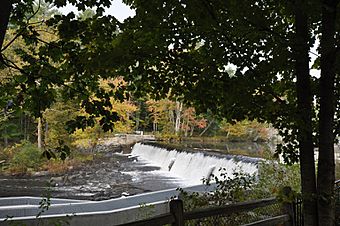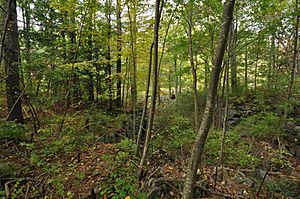Wiswall Falls Mills Site facts for kids
Quick facts for kids |
|
|
Wiswall Falls Mills Site
|
|

The 1912 Wiswall Falls Dam
|
|
| Location | John Hatch Park, south of Wiswall Road just east of the Lamprey River, Durham, New Hampshire |
|---|---|
| Area | 3 acres (1.2 ha) |
| Built by | Wiggin, Moses |
| NRHP reference No. | 88000184 |
| Added to NRHP | March 18, 1988 |
The Wiswall Falls Mill Site is a special historical place in Durham, New Hampshire. It's an archaeological site, which means it holds the remains of old buildings and structures. You can find it in John Hatch Park, a small public park by the Lamprey River.
This site covers about 3 acres (1.2 hectares). It shows us what's left of a busy group of mills from the 1800s. These mills were very important for Durham's economy back then. Sadly, they burned down in 1883. Today, you can still see parts of the water systems and building foundations. Because of its history, the site was added to the National Register of Historic Places in 1988.
Contents
What You Can See at the Site
The Wiswall Falls Mill Site is now in a quiet, natural area in Durham. The main things you can see are the old foundations of a sawmill, a paper mill, a dam, and a power canal. There are also parts of other buildings that helped the mills run.
Key Features of the Site
The most noticeable parts of the site today are a concrete dam and a stone-lined power canal. The concrete dam was built in 1912 across the Lamprey River. The power canal, which is partly filled in now, created a small island on the east side of the river. If you look closely, you can see the remains of an older wooden dam from 1835 under the water near the current dam. On both sides of where the power canal used to be, you can spot the foundations of different buildings.
A Look Back at the Mills' History
This area became very active with industry starting in 1835. That's when Moses Wiggin built the first wooden dam and a sawmill. Later, in 1854, Thomas Wiswall built the power canal and a paper mill.
Why the Mills Closed Down
The paper mill unfortunately burned down in 1883. The sawmill was left empty and later taken apart after floods damaged the dam in the 1890s. The Wiswall Mill was the biggest industrial site in Durham. Other mills in town were much smaller. Durham's economy faced challenges in the late 1800s. This was partly because the railroad lines were built away from the town center and other places where factories could have grown.
From Mills to Power Generation
Around 1900, the site was changed to produce electricity using water power. A new concrete dam was built in 1912 to help make more electricity. The power plant stopped working in the 1940s. After that, the town used the water held back by the dam as part of its water supply.
The town of Durham bought the property in 1967. They have since made the area nice for visitors. You can walk around and see the interesting remains of the old mills that once stood here.




